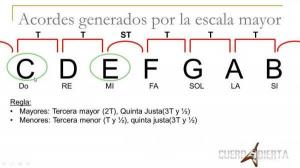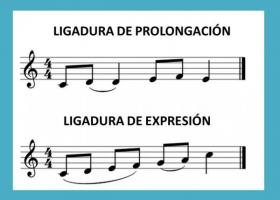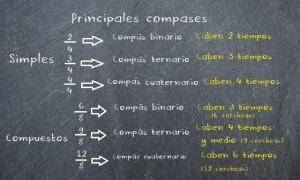Musical polyphony: characteristics and examples
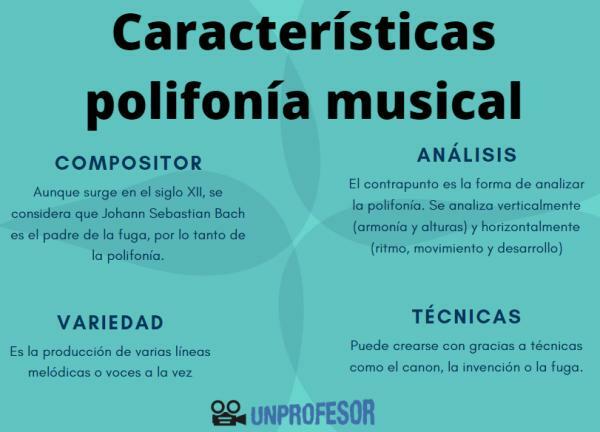
Music is a beautiful art, a discipline that studies sound and its properties with the aim of expression. Thanks to its persistence throughout history and the passing of time, techniques have been developed to make it more and more perfect and wonderful. In this lesson from a TEACHER we will talk about one of these fundamental techniques in the composition of music, the musical polyphony: characteristics and examples, so you can understand more about this concept in the workings of the fundamentals of classical music.
Index
- Definition of musical polyphony and characteristics
- Origin and development of polyphony
- Polyphonic techniques
- Examples of polyphony: composers and notable works
Definition of musical polyphony and characteristics.
The word polyphony It is etymologically composed of two words that come from the Greek: "polis", which means many or many and "phonos" which means sounds. So polyphony happens in music when 2 or more independent voices sound simultaneously.
It is also important not to confuse polyphony with the technique and concept of "homophony" which is when a main voice is harmonically accompanied by chords, since in polyphony voices have a melodic function and not just an accompaniment. To better understand this concept, here is a summary with the characteristics of polyphony.
Polyphony Characteristics
- It is related to the production of various melody lines or voices at once. As you know, in music we can have a simple melody, but this melody is composed in principle of a single voice. In contrast, when the music becomes more complete, we can add more than a single melodic line and that is when the polyphony occurs.
- The opposite of polyphony would be "monophony” which is music with a single voice.
- It's analized vertically (harmony and heights) and horizontally (rhythm, movement and development).
- Another characteristic of polyphony is that it is directly related to the counterpointas it is the way to analyze polyphony.
- The more voices there are in the polyphony, the more complex the analysis of the counterpoint.
- It can be created with thanks to techniques such as canon, invention or leakage.
- Arises in the twelfth century.
- Johann Sebastian is considered Bach is the father of fugue, hence of polyphony.

Image: Pinterest
Origin and development of polyphony.
Now that you know the characteristics of polyphony, let's delve into its history. Polyphony is a technique that arises in the twelfth century and begins to be explored in depth during the Middle Agesand the Renaissance, becoming a characteristic factor of the music of these times. We can say that polyphony arose from melismatic organum which was the first technique to harmonize the song and was implemented to beautify liturgical music, such as the Gregorian singing. Other polyphony techniques of the time were the “discantus”(When the voices move by opposite and not parallel movements) and the“motet”(Made up of 3 or more voices and including a deep voice for bass).
Although at first monody (composition techniques with only one main voice) still dominated in recurrence, with the passage of time the polyphonic technique was implemented. The next big step in its evolution was during the Baroque in the 18th century, when musicians like Johann Sebastian Bach and Georg Friedrich Händel they explored counterpoint techniques (the rhythmic and harmonic relationship of the notes with each other) and developed polyphonic techniques and complex forms such as the fugue.
From this time on, in the periods to come such as classicism, romanticism and the twentieth century focused on developing the principles already using them to elevate expression with longer and more expressive musical phrases or to experiment with the tonal system and dissonance.
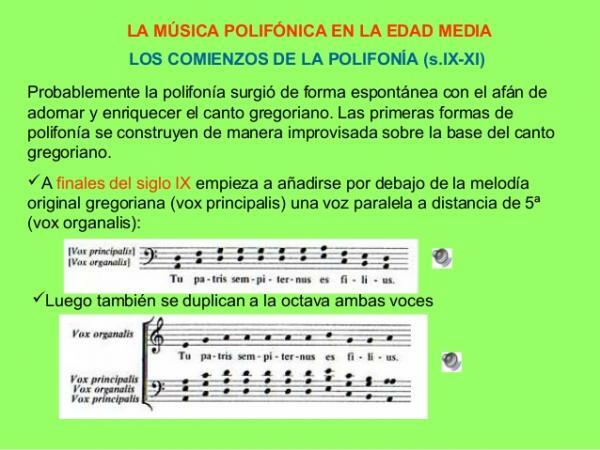
Image: Slideshare
Polyphonic techniques.
It is also important that we know the techniques of polyphony to better understand this composition. These are some of the compositional techniques used for polyphony:
Canyon
It is a musical technique that is based on the development of a motive or main subject. The canon takes this motif and shifts it rhythmically or in pitch, to create counterpoint and polyphony.
Invention
Rhythmically alternate voices and modify aspects in intervals to create variation.
Leakage
It is also a technique based on the imitation of subjects or motifs, but it has a much more specific and complex structure. A fugue is made up of the following parts: Exposition, counter-exposition, episodes, Strait or Stretto, and conclusion.
Examples of polyphony: composers and outstanding works.
We conclude this lesson by talking about the most popular Polyphony Examples. They are works composed by highly acclaimed musicians, among which we highlight the following:
- Johann Sebastian Bach: It is important to note that Bach is considered the father of fugue, so if you want a good example of polyphony, this is one of the ideal composers to start listening to. Bach composed a series of fugues (14) and canons (4), published as "The art of the fugue, BWV 1080", using a single motif or subject, to explore all the possibilities, so this is a good point to get started.
- Guillaume de Machaut: Messe de Nostre Dame.
- Josquin des Prez: Pange Lingua Mass.
- Jacob Obrecht
- Orlando di Lasso: Mass super Bella Amfitrit altera.
- Johannes Ockenghem
- Thomas tallis
- Alonso Lobo: Motet Versa est in Luctum.
- William Byrd: Mass for five voices.
- Palestrina: Mass Papae Marcelli.
- Tomas Luis de Victoria
- Gregorio Allegri: Miserere
- Georg Friedrich Händel: Dixit Dominus,
Now that you have expanded your knowledge about the concept of musical polyphony, it would be interesting if you could dedicate yourself to listen to the works of outstanding composers, so that you can get acquainted with polyphony not only theoretical, but aurally.
If you want to read more articles similar to Musical polyphony: characteristics and examples, we recommend that you enter our category of Musical language.

